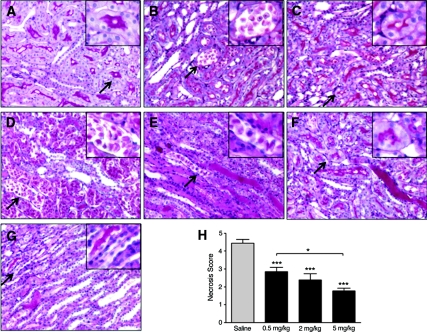Figure 2.
SS-31 reduced tubular injury after ischemia. Rats were subcutaneously treated with saline or SS-31 (0.5, 2 or 5 mg/kg) 30 minutes before bilateral occlusion of renal blood flow for 30 or 45 minutes. Treatment was repeated just before onset of reperfusion and at 2 hours after reperfusion. Kidney sections were stained with PAS. Representative sections from the outer medulla are shown in panels A through G, Magnification: ×200. Inset shows higher magnification of area indicated by the arrow. (A) Kidneys from Sham-operated rats showed normal architecture in the OSOM with prominent brush borders in the proximal tubules (see inset). (B) Focal necrosis was found in the OSOM of saline-treated animals after 30-minute ischemia (inset shows cell sloughing). (C) Necrosis was rare in the SS-31-treated animals after 30-minute ischemia, and brush borders were preserved in many proximal tubules (see inset). (D) Extensive tubular necrosis was found in the OSOM of saline-treated animals after 45-minute ischemia. (E) Architecture of the ISOM was greatly distorted in saline-treated animals after 45 minutes ischemia, and tubules were filled with hyaline casts and sloughed cells. (F) Only focal necrotic areas were observed in the OSOM of SS-31-treated animals after 45-minute ischemia. (G) Architecture of the ISOM was greatly protected by SS-31, with few sloughed cells and occasional casts after 45-minute ischemia. (H) Cell necrosis score after 45-minute ischemia showing dose-dependent protection provided by SS-31 treatment. n = 12 to 14 in each group. ANOVA revealed significant differences among the four groups (P < 0.0001). ***P < 0.001 compared with saline; *P < 0.05 between groups as indicated.

